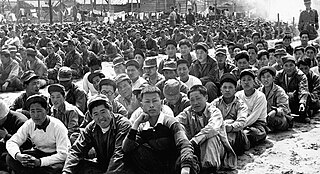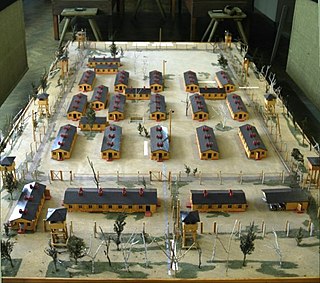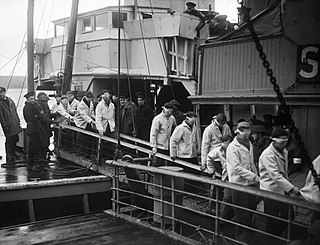The following list includes prisoner-of-war camps during World War II, both allied and axis:

A prisoner of war (POW) is a person who is held captive by a belligerent power during or immediately after an armed conflict. The earliest recorded usage of the phrase "prisoner of war" dates back to 1610.

World War II was the deadliest military conflict in history. An estimated total of 70–85 million people perished, or about 3% of the 2.3 billion (est.) people on Earth in 1940. Deaths directly caused by the war are estimated at 50–56 million, with an additional estimated 19–28 million deaths from war-related disease and famine. Civilian deaths totaled 50–55 million. Military deaths from all causes totaled 21–25 million, including deaths in captivity of about 5 million prisoners of war. More than half of the total number of casualties are accounted for by the dead of the Republic of China and of the Soviet Union. The tables below give a detailed country-by-country count of human losses. Statistics on the number of military wounded are included whenever available.

The Rheinwiesenlager were a group of 19 camps built in the Allied-occupied part of Germany by the U.S. Army to hold captured German soldiers at the close of the Second World War. Officially named Prisoner of War Temporary Enclosures (PWTE), they held between one and almost two million surrendered Wehrmacht personnel from April until September 1945.

The final battles of the European Theatre of World War II continued after the definitive overall surrender of Nazi Germany to the Allies, signed by Field marshal Wilhelm Keitel on 8 May 1945 in Karlshorst, Berlin. After German dictator Adolf Hitler's suicide and handing over of power to grand admiral Karl Dönitz in May of 1945, the Soviet troops conquered Berlin and accepted surrender of the Dönitz-led government. The last battles were fought as part of the Eastern Front which ended in the total surrender of all of Nazi Germany’s remaining armed forces such as in the Courland Pocket in western Latvia from Army Group Courland in the Baltics surrendering on 10 May 1945 and in Czechoslovakia during the Prague offensive on 11 May 1945.

Disarmed Enemy Forces was a US designation for soldiers who surrendered to an adversary after hostilities ended, and for those POWs who had already surrendered and were held in camps in occupied German territory at the time. It was General Dwight D. Eisenhower's designation of German prisoners in post–World War II occupied Germany.

A prisoner-of-war camp is a site for the containment of enemy fighters captured by a belligerent power in time of war.

In Germany, stalag was a term used for prisoner-of-war camps. Stalag is a contraction of "Stammlager", itself short for Kriegsgefangenen-Mannschaftsstammlager, a literal translation of which is "War-prisoner" "enlisted" "main camp". Therefore, technically "stalag" simply means "main camp".
In customary international law, an enemy alien is any native, citizen, denizen or subject of any foreign nation or government with which a domestic nation or government is in conflict and who is liable to be apprehended, restrained, secured and removed. Usually, the countries are in a state of declared war.
Allied war crimes include both alleged and legally proven violations of the laws of war by the Allies of World War II against either civilians or military personnel of the Axis powers. At the end of World War II, many trials of Axis war criminals took place, most famously the Nuremberg Trials and Tokyo Trials. In Europe, these tribunals were set up under the authority of the London Charter, which only considered allegations of war crimes committed by people who acted in the interests of the Axis powers. Some war crimes involving Allied personnel were investigated by the Allied powers and led in some instances to courts-martial. Some incidents alleged by historians to have been crimes under the law of war in operation at the time were, for a variety of reasons, not investigated by the Allied powers during the war, or were investigated but not prosecuted.
A civilian internee is a civilian detained by a party to a war for security reasons. Internees are usually forced to reside in internment camps. Historical examples include Japanese American internment and internment of German Americans in the United States during World War II. Japan interned 130,000 Dutch, British, and American civilians in Asia during World War II.

Herzogenbusch was a Nazi concentration camp located in Vught near the town of 's-Hertogenbosch, Netherlands. The camp was opened in 1943 and held 31,000 prisoners. 749 prisoners died in the camp, and the others were transferred to other camps shortly before Herzogenbusch was liberated by the Allied Forces in 1944. After the war, the camp was used as a prison for Germans and for Dutch collaborators. Today there is a visitors' center which includes exhibitions and a memorial remembering the camp and its victims.
The following outline is provided as an overview of and topical guide to World War II:
This is a list of World War II-related topic lists:
This is a timeline of events that occurred during World War II in 1943.
During World War II, it has been estimated that between 19,500 and 50,000 members of the Imperial Japanese military surrendered to Western Allied combatants prior to the end of the Pacific War in August 1945. Also, Soviet troops seized and imprisoned more than half a million Japanese troops and civilians in China and other places. The number of Japanese soldiers, sailors, marines, and airmen who surrendered was limited by the Japanese military indoctrinating its personnel to fight to the death, Allied combat personnel often being unwilling to take prisoners, and many Japanese soldiers believing that those who surrendered would be killed by their captors.

Red Cross parcel refers to packages containing mostly food, tobacco and personal hygiene items sent by the International Association of the Red Cross to prisoners of war during the First and Second World Wars, as well as at other times. It can also refer to medical parcels and so-called "release parcels" provided during World War II.

Members of the German military were interned as prisoners of war in the United States during World War I and World War II. In all, 425,000 German prisoners lived in 700 camps throughout the United States during World War II.

The history of Arizona during World War II begins in 1940, when the United States government began constructing military bases within the state in preparation for war. Arizona's contribution to the Allied war effort was significant both in terms of manpower and facilities supported in the state. Prisoner of war camps were operated at Camp Florence and Papago Park, and there was an internment camp to house Japanese-Americans, most of them citizens, who had been forcibly deported from the West Coast.

Large numbers of German prisoners of war were held in Britain between the outbreak of the Second World War in September 1939 and late 1948. Their numbers reached a peak of around 400,000 in 1946, and then began to fall when repatriation began. The experiences of these prisoners differed in certain important respects from those of captured German servicemen held by other nations. The treatment of the captives, though strict, was generally humane, and fewer prisoners died in British captivity than in other countries. The British government also introduced a programme of re-education, which was intended to demonstrate to the POWs the evils of the Nazi regime, while promoting the advantages of democracy. Some 25,000 German prisoners remained in the United Kingdom voluntarily after being released from prisoner of war status.